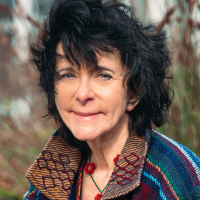
I write oddly disparate books—poetry, fiction, and nonfiction—on widely different subjects: wildlife, Darwin, music, history and travel. It might seem that inspiration comes from the air around me, but I’ve learned it’s the opposite. It comes from deep within, and my job is to listen. The first spark comes from the endlessly fascinating world: history, science, knowledge, trying to understand the Other. The second, like thunder rumbling behind the lightning, comes from excavating what it means to me.
I wake early and go straight into writing with a cup of coffee. I am currently in Sri Lanka rewriting and conducting the last parts of research for a book on Asian elephants. It will draw from the environment, science, travel, and history, but also my love of wild animals—their needs and their nature, their relation with their environment, and how I feel while watching them wild. I am no zoologist, but zoology inspires me. My deepest inspiration is being in the forest, watching the whole bright tangle—trees, wildlife, tracks, smells and birdsong—in which the elephants evolved to exist: the secret hush they move in. Also knowledge: the deep sign-language knowledge of the earth, possessed by people who live in the forest, and the knowledge of conservation scientists, especially about animal behavior, and the interactions of every animal and plant. I try to be aware of whatever is calling me to explore, and to make my own sense of it. Alice Walker said, “The soul has to be listened to,” and when I can’t do that, I take a walk—preferably in nature, but it might be simply to the shops. Being among people, watching the world as it goes on, restores me.
I have just finished a poetry collection called Girl, a trilogy introduced by the life of the Virgin Mary and ending with the Minoan Snake Goddess. In between are poems on what it has meant to me to be a girl, looking at snapshots of my own life but also my mother’s and my daughter’s lives, through the lens of “girl.” My main inspirations here lay in people, landscapes, and memories of growing up. Later on, inspiration came unexpectedly at a friend’s dinner table when a Californian photographer showed me pictures she had taken of ballerinas underwater. That idea—a woman photographing a girl, one artist observing another, both at work in such a strange environment for the brief time-flash of a single breath—was the inspiration for one of the final poems. Being open to the world, observing as closely as I can what is there to see, listening as closely as I can to how I react to it and why, and through that, looking for the invisible within and beyond the visible, provides the most decisive inspiration of all.
—Ruth Padel, author of Beethoven Variations: Poems on a Life (Knopf, 2021)
Photo credit: Donna Ford
Please log in to continue.
LOG IN
Don't yet have an account?
SIGN UP NOW -- IT'S FREE!







